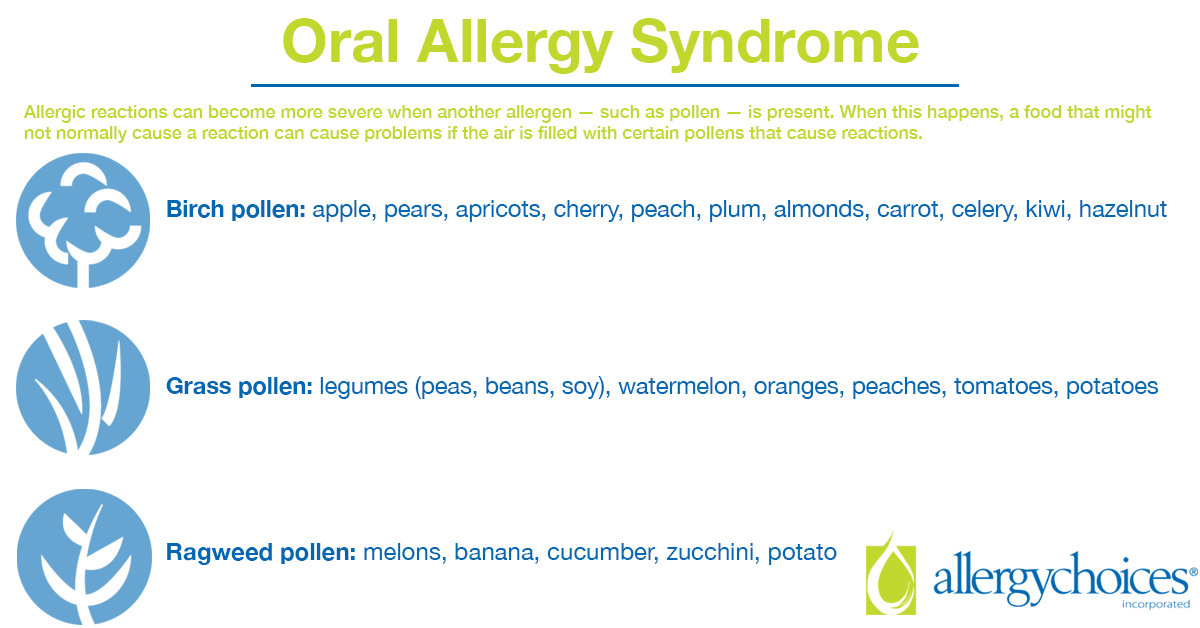Oral Allergy Syndrome: When food reactions come and go

After a long, cold winter, you are ready to go outside and enjoy the fresh, warm air. Then it hits you, seasonal allergy symptoms! Your nose is stuffy, your eyes itch, and you cannot stop sneezing. The trees outside of your house are making you miserable. So you come to terms with having to hide inside the house a bit longer. Then out of nowhere your mouth begins to tingle, and your lips begin to swell after eating an apple. This is new and has never occurred before. What is going on? What is happening? After all, you have never been diagnosed with a food allergy before and apples are a staple in your diet!
Oral Allergy Syndrome
This incident is known as Oral Allergy Syndrome (OAS), otherwise known as pollen food allergy syndrome and is most common in adults. Oral allergy syndrome can occur when a person has an environmental allergy to the pollens of trees, grasses, and weeds. Some people can then react to raw fruits, vegetables, or nuts. This process is due to similar amino acid chains or more simply, protein structures, in pollens which also resemble the proteins in certain foods. This is called cross-reactivity. The foods and pollens do not need to be related botanically for this to occur. Ultimately, your immune system can become overwhelmed, resulting in an allergic reaction. Remember, it is the protein in foods and pollens that we are allergic to.
Airborne allergens most associated with oral allergy syndrome include birch, grass, and ragweed pollens. Some of the foods commonly associated with these pollens include:
- Birch pollen: apple, pears, apricots, cherry, peach, plum, almonds, carrot, celery, kiwi, hazelnut
- Grass pollen: legumes (peas, beans, soy), watermelon, oranges, peaches, tomatoes, potatoes
- Ragweed pollen: melons, banana, cucumber, zucchini, potato
Symptoms can occur even if you have tolerated the food in the past. Symptoms of OAS are contained to the oral cavity and can include itching, tingling, swelling of the lips or tongue, blisters of the mouth tissues and very occasionally tightness of the throat. Symptoms occur within 5 to 30 minutes of eating the food and do not tend to last long. It is important to note that a person experiencing OAS may only react to a single food or multiple foods, but only the food or foods causing symptoms need to be avoided. It is unnecessary to restrict foods which do not cause symptoms. It is essential to prevent over restriction of foods or food groups if it is not necessary. Variety of foods in the diet is key to good nutrition.
The good news is that many people can tolerate and eat these same foods in cooked form. Cooking a fruit or vegetable breaks down the protein structure so they no longer resemble the original protein arrangement, thus making it tolerable for most people with OAS. Many people are only bothered by OAS during their peak pollen season. Therefore the remaining portion of the year, the fruit, vegetable or nut causes no symptoms at all.
Remember, not everyone with an environmental allergy to pollens will experience OAS. For those people who do experience OAS, it is important to pinpoint which foods are the culprits.
Though OAS is a nuisance, it usually causes minimum distress for most people. If you are a lucky one that is only bothered with OAS during your peak pollen season, hang in there, as it will pass. For those who experience OAS symptoms year round, it will require a bit more monitoring.
What should I do if I have Oral Allergy Syndrome?
If you suffer from OAS, make sure you are getting adequate nutrition by only avoiding those foods which cause symptoms. Making an appointment with an allergist is always a good idea to ensure your allergies are well controlled and the specific foods causing symptoms are known. The good news is that sublingual immunotherapy, especially using the La Crosse Method Protocol™, enables your provider to safely address the cause and build tolerance for environmental and food allergies.
If your food restrictions are overwhelming, speak with a dietitian who is knowledgeable regarding food allergies to ensure you are maximizing your nutrition. With the right information in your toolbox, and the right treatment options to help you treat the cause of your allergies, you can still live and enjoy your life to the fullest!
Author: Emily Melby, RDN

